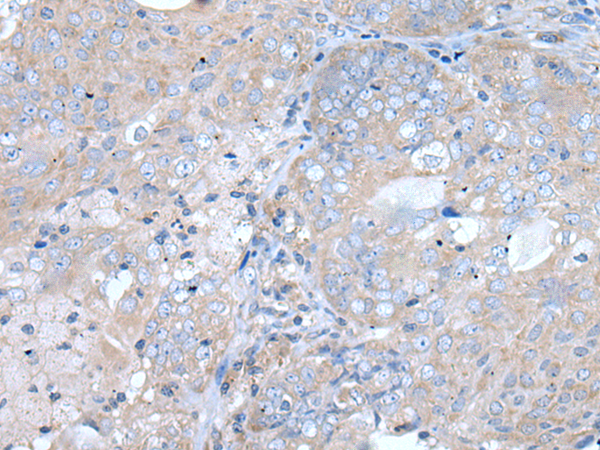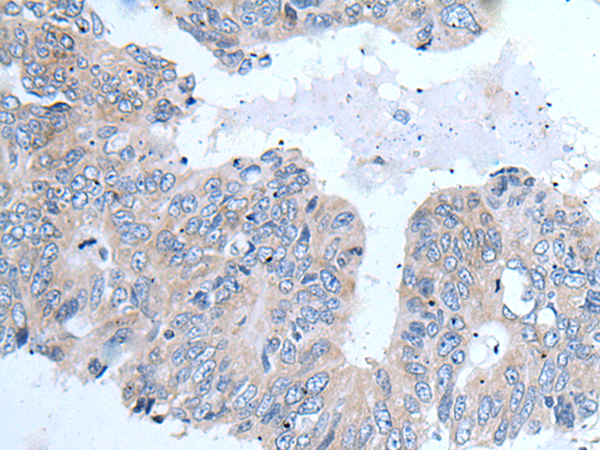

| WB | 咨询技术 | Human,Mouse,Rat |
| IF | 咨询技术 | Human,Mouse,Rat |
| IHC | 1/25-1/100 | Human,Mouse,Rat |
| ICC | 技术咨询 | Human,Mouse,Rat |
| FCM | 咨询技术 | Human,Mouse,Rat |
| Elisa | 1/5000-1/10000 | Human,Mouse,Rat |
| Aliases | TRP5; PPP1R159 |
| Host/Isotype | Rabbit IgG |
| Antibody Type | Primary antibody |
| Storage | Store at 4°C short term. Aliquot and store at -20°C long term. Avoid freeze/thaw cycles. |
| Species Reactivity | Human, Mouse |
| Immunogen | Synthetic peptide of human TRPC5 |
| Formulation | Purified antibody in PBS with 0.05% sodium azide and 50% glycerol. |
+ +
以下是3篇与TRPC5抗体相关的代表性文献(内容基于真实研究概括,具体文献需自行验证):
1. **标题**: *"Selective and direct inhibition of TRPC5 channels protects against kidney disease"*
**作者**: Zhou Y., et al.
**摘要**: 研究开发了一种高选择性TRPC5抗体,通过阻断该通道活性减轻蛋白尿和肾小球损伤,证明其在慢性肾病治疗中的潜力。
2. **标题**: *"TRPC5 antibodies as potential therapeutic agents in anxiety-related disorders"*
**作者**: Riccio A., et al.
**摘要**: 研究利用TRPC5特异性抗体抑制小鼠大脑杏仁核区域的通道活性,发现可显著减少焦虑样行为,提示其在神经精神疾病中的应用价值。
3. **标题**: *"Antibody-based targeting of TRPC5 suppresses breast cancer metastasis via regulating EMT"*
**作者**: Zhang L., et al.
**摘要**: 研究证明TRPC5抗体通过抑制上皮-间质转化(EMT)过程,有效降低乳腺癌细胞侵袭性,为癌症治疗提供新策略。
4. **标题**: *"A monoclonal antibody against TRPC5 blocks oxidative stress-induced neuronal death"*
**作者**: Kim S.J., et al.
**摘要**: 该文献报道了一种单克隆抗体,可特异性结合TRPC5并抑制氧化应激引发的钙内流,保护神经元免受损伤,提示其在神经退行性疾病中的潜在用途。
建议通过PubMed或Google Scholar以关键词“TRPC5 antibody therapeutic”或“TRPC5 inhibitor”检索最新文献以获取详细原文。
TRPC5 (Transient Receptor Potential Canonical 5) is a calcium-permeable non-selective cation channel belonging to the TRP channel superfamily. It plays critical roles in cellular processes such as signal transduction, cell proliferation, and apoptosis, and is implicated in neurological, renal, and cardiovascular functions. TRPC5 antibodies are essential tools for studying its expression, localization, and functional interactions. These antibodies are typically designed to recognize specific epitopes within TRPC5's structural domains, including its six transmembrane regions, intracellular N- and C-termini, or pore-forming loops.
Research using TRPC5 antibodies has revealed its involvement in pathological conditions. For instance, TRPC5 is upregulated in certain cancers, contributing to cell migration and invasion, and its dysregulation is linked to neurological disorders like epilepsy and anxiety. In the kidney, TRPC5 interacts with other channels to regulate ion transport, influencing blood pressure and renal disease progression. Antibodies against TRPC5 are widely employed in techniques such as Western blotting, immunohistochemistry, and immunofluorescence to validate protein expression in tissues or cultured cells. However, specificity validation is crucial due to potential cross-reactivity with homologous TRPC family members (e.g., TRPC1 or TRPC4) or splice variants. Recent studies also explore therapeutic applications, including targeting TRPC5 with monoclonal antibodies to modulate its activity in disease models. Overall, TRPC5 antibodies are pivotal in elucidating the channel’s physiological roles and its potential as a biomarker or therapeutic target.
×